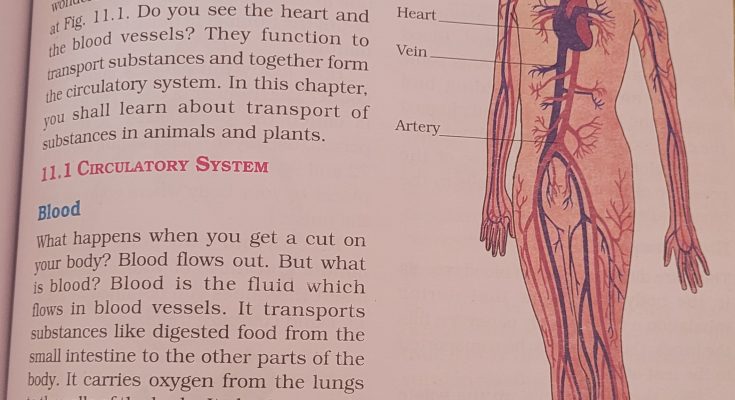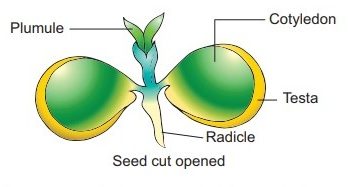Table of Contents
Purpose of Transportation in Organisms
- All organisms require essential substances like food, water, and oxygen for survival. These substances need to be transported to various parts of their bodies.
- Waste products generated in the body need to be transported to parts where they can be removed.
Circulatory System
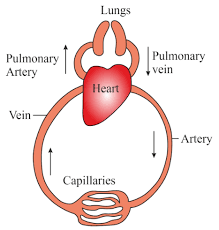
Components
- Consists mainly of the heart and blood vessels.
- Functions collectively to transport substances, forming the circulatory system.
Blood
Definition
- A fluid that flows within blood vessels.
Functions
- Transports digested food from the small intestine to other body parts.
- Carries oxygen from the lungs to body cells.
- Transports waste for removal from the body.
Composition
- Plasma– A fluid in which different types of cells are suspended.
- Red Blood Cells (RBCs)-
- Contains haemoglobin, a red pigment.
- Haemoglobin binds with oxygen and helps in transporting it to all body parts.
- White Blood Cells (WBCs)-
- Helps in fighting against germs that enter the body.
- Platelets-
- Assist in the clotting of blood, preventing excessive bleeding from injuries.
Also Check – Composition Of Blood – in details
Haemoglobin
- Role-
- Essential for efficiently transporting oxygen to all cells in the body.
- Makes blood appear red due to its presence.
Importance of Different Blood Cells
- RBCs
- Specialised in oxygen transportation due to haemoglobin.
- WBCs
- Act as the body’s defence mechanism against foreign particles and germs.
- Platelets
- Play a crucial role in blood clotting, preventing infections and excessive bleeding from wounds.
- In case of an injury, like a cut, platelets in the blood help form a clot that stops the bleeding and aids in wound healing.
Circulatory System- A system that facilitates the transportation of essential substances and waste products in the body.
Blood Components- Includes plasma, RBCs, WBCs, and platelets, each having specific functions in transportation and immunity.
Haemoglobin- A vital component in RBCs that ensures efficient oxygen transportation to the body cells.
Blood Donation
- Importance- Essential for saving lives; counteracts shortages leading to preventable deaths.
- Safety- Voluntary blood donation is harmless and virtually painless.
Places for Blood Donation
- Location- Hospitals and authorised centres by the government.
Blood Banks
- Role- Facilities specialised in collecting, testing, processing, and storing donated blood.
- Importance- Ensures the availability of safe and matching blood for transfusion when needed.
Blood Vessels
Types of Blood Vessels

Arteries- High-Pressure Oxygen Carriers
Anatomy and Structure-
- Arteries are robust and elastic vessels. They are designed to handle the high pressure of blood that the heart pumps directly into them.
- Their walls are muscular and thick, which allows them to both withstand and maintain the fast and forceful flow of oxygen-rich blood.
Role in Circulation-
- Arteries serve as the primary highways of the circulatory system, beginning their journey from the heart.
- They carry oxygen-loaded blood from the heart, spreading out to all the tissues and organs.
Branching and Reach-
- As arteries move away from the heart, they branch into smaller vessels, extending the reach of oxygenated blood to every cell in the body.
Veins- The Return Channels
Anatomy and Structure-
- Veins are constructed with thinner walls compared to arteries. Their internal structure includes valves that prevent the backward flow of blood.
- These vessels are more flexible, adapting to the lower pressure of the returning blood.
Role in Circulation-
- They act as return channels, carrying carbon dioxide-rich blood, filled with waste materials, back to the heart and lungs for purification.
- The one-way valves ensure that the deoxygenated blood flows back to the heart efficiently, preventing any backward flow.
Also Check – Differences between Arteries and Veins for Class 7
The Exception- Pulmonary Artery and Vein
Pulmonary Artery-
- Unlike other arteries, the pulmonary artery carries oxygen-poor, carbon dioxide-rich blood.
- Its journey starts at the heart, from where it transports this blood to the lungs for a vital exchange of gases.
Why Still an Artery?
- Classification as an artery is due to its origin from the heart, even though it carries oxygen-depleted blood.
Pulmonary Vein-
- In an exception to the conventional vein roles, the pulmonary vein carries oxygen-rich blood.
- It brings the oxygenated blood from the lungs back to the heart, ensuring that the oxygen reaches body tissues.
Capillaries- The Ultimate Exchange Points

Formation and Structure-
- Arteries, in their journey away from the heart, branch out and become progressively smaller, finally becoming thin-walled capillaries.
- These are the smallest blood vessels where the walls are just one cell thick, facilitating the exchange process.
Role in Exchange-
- Capillaries are embedded in body tissues, enabling the intimate and efficient exchange of oxygen, nutrients, and waste materials between the blood and body cells.
- They form an extensive network, maximising the area for exchange and ensuring that each cell gets its supply of oxygen and nutrients and gets rid of wastes.
Blood Circulation Process-
Oxygen Transport-
- Freshly oxygenated blood is pumped from the heart into the arteries, which branch extensively to deliver oxygen to every cell.
Carbon Dioxide and Waste Removal-
- Veins collect the deoxygenated blood, rich in waste products, channelling it back to the heart, which then pumps it to the lungs for purification.
Capillary Exchange-
- The capillaries play a crucial role in the exchange of materials. Oxygen and nutrients pass from the blood through capillary walls to the body’s cells, and waste products move from the cells to the blood.
Cycle Continuation-
- This cycle continues perpetually, maintaining the delivery of essential substances to the cells and ensuring the removal of waste products, keeping the body alive and functioning optimally.
Pulse
- Definition- The rhythmic throbbing or vibration that can be felt in various parts of the body, especially on the wrist, due to the flow of blood through arteries.
- Origin- The pulse originates from the heart’s contractions, pushing blood into the arteries.
- Purpose of Pulse- It provides a tangible sign of the heart’s activity and indicates the rate at which the heart is beating.
Activity – Observing the Pulse
Procedure-
- Place the index and middle fingers of the right hand on the inner side of the left wrist.
- Feel for the rhythmic throbbing. This sensation is the pulse.
- Count the number of throbs or beats in one minute to determine the pulse rate.
Pulse Rate-
- Definition- The number of heartbeats or pulses felt in one minute.
- Typical Range- For a resting person, the pulse rate typically ranges between 72 and 80 beats per minute.
- Variability- Pulse rate can vary based on factors like age, health, activity level, and more.
Pulse Points in the Body-
- While the wrist is a common location to check the pulse, there are other areas in the body where the pulse can be felt. Some students might discover these other points during the activity.
Comparative Analysis-
- After measuring their own pulse rates, students can compare their results with those of their classmates.
- They can record this data in a table, which will show the variability of pulse rates among different individuals.
Table- Pulse Rate Comparative Data
| S. No. | Name | Pulse per minute |
| 1. | [Student Name] | [Pulse Rate] |
| 2. | [Student Name] | [Pulse Rate] |
| … | … | … |
Heart and its Function in the Circulatory System
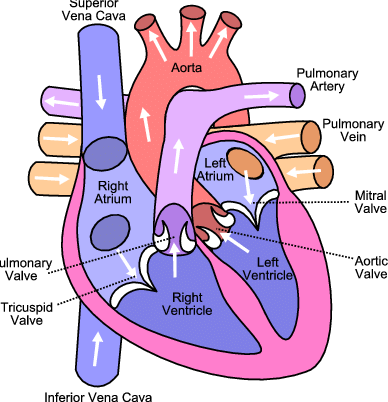
Location and Structure
- The heart is a remarkable muscular organ situated in the chest cavity. Positioned slightly towards the left, it works tirelessly as a powerful pump. Its size is roughly analogous to that of a closed fist.
Chambers of the Heart
- The heart is compartmentalised into four chambers to prevent the oxygen-rich blood from mingling with the blood laden with carbon dioxide. The upper two compartments are the atria (singular- atrium), and the lower two are the ventricles.
- Atria- These are the receiving chambers. They receive blood returning to the heart from various body parts.
- Ventricles- These chambers pump blood out of the heart to various parts of the body.
Partitioning and Function
- Precise partitioning in the heart avoids the mixing of oxygen-rich and carbon dioxide-rich blood, ensuring that the body receives a consistent supply of oxygenated blood.
- Walls called septa separate these chambers, maintaining the distinction between oxygenated and deoxygenated blood.
Flow of Blood
- The direction of blood flow within the heart is meticulously organised. Starting from the right side of the heart, blood flows towards the lungs, gets oxygenated, returns to the heart’s left side, and is then propelled into the rest of the body.
Oxygen-Rich and Carbon Dioxide-Rich Blood
- The left side of the heart is designated for oxygen-rich blood. After oxygenation in the lungs, blood travels back to the heart and is received by the left atrium. It then moves to the left ventricle, which pumps it out to supply various body parts.
- Conversely, the right side of the heart deals with carbon dioxide-rich blood. It receives deoxygenated blood from the body, which is then sent to the lungs for oxygenation.
Also Check – How Blood Flow in Heart ?
Functioning of the Heart in the Circulatory System
Sequential Pumping
- The heart operates in a well-coordinated sequence. Initially, the atria receive the blood. The right atrium gets deoxygenated blood from the body, and the left atrium receives oxygenated blood from the lungs. Once the atria are filled, they contract to push the blood into the ventricles.
Ventricular Action
- After the atria, the ventricles take over. The right ventricle pumps the received deoxygenated blood to the lungs for oxygenation. Simultaneously, the left ventricle propels the oxygenated blood to various parts of the body, ensuring that every cell receives the necessary oxygen and nutrients for its functioning.
Valves in Action
- Valves within the heart play a crucial role in this process, ensuring a one-way flow of blood. They prevent the backflow, maintaining a unidirectional flow, which is crucial for the effective transportation of blood.
Pulse and Rhythmic Contraction
- The rhythmic contraction and relaxation of the heart muscles, also known as the heartbeat, ensures the continuous flow of blood. This consistent mechanism keeps the circulation in motion, supplying essential substances throughout the body.
Significance of Sequential Functioning
- This organised sequence in the heart’s functioning is essential for effective and efficient circulation. It guarantees that each part of the body receives oxygenated blood, necessary for cellular activities, and at the same time, deoxygenated blood is timely sent for oxygenation.
Heartbeat
Definition and Importance
- A heartbeat is a vital sign of life, characterised by the rhythmic contraction and relaxation of the heart muscles.
- This persistent rhythm occurs every moment, ensuring the continual flow of blood, thus oxygen and nutrients, throughout the body.
Muscular Walls-
- The heart’s chambers have muscular walls that actively participate in heartbeats.
- These muscles undergo rhythmic contractions and relaxations, driving the heart’s pumping action.
Sensing the Heartbeat-
- The heartbeat can be felt by placing a hand on the left side of the chest.
- It is a tangible rhythm, a physical embodiment of life’s continuous cycle in the biological realm.
Stethoscope – A Doctor’s Tool-
- Doctors use an instrument known as a stethoscope to listen more precisely to heartbeats.
- A stethoscope amplifies the sounds of the heart, allowing for detailed auditory analysis.
Structure of the Stethoscope-
- It comprises various parts such as a sensitive diaphragm located in the chest piece and two earpieces connected by a tube.
- These components work collectively to convey the heart’s sounds with clarity and precision.
Diagnostic Relevance-
- Listening to the heartbeats allows doctors to glean essential information regarding the heart’s condition.
- Variations in the heartbeat’s rhythm, strength, or consistency can be indicative of different heart conditions, enabling accurate diagnostics and effective treatments.
Constructing a Stethoscope
Objective
- Understanding the concept of heartbeat and pulse rate by creating a simple stethoscope.
Materials Required-
- Small funnel (6-7 cm diameter)
- Rubber tube (50 cm long)
- Rubber sheet or balloon
- Rubber band
Procedure-
- Attach the rubber tube tightly to the stem of the funnel.
- Stretch the rubber sheet or balloon over the tunnel’s mouth, securing it with a rubber band.
- Place the tube’s open end to an ear, and the tunnel’s mouth near the heart on the chest.
Observations-
- A regular thumping sound, representing the heartbeat, should be audible.
- The heartbeat’s rate can be counted before and after physical activity like running.
Relationship between Heartbeat and Pulse Rate
Finding the Connection-
- One pulse in the arteries is generated with each heartbeat.
- Thus, the pulse rate per minute indicates the heartbeat rate, showing a direct relationship.
Circulatory System in Different Animals
Sponges and Hydra-
- Lack a defined circulatory system.
- Their survival doesn’t rely on blood for transportation of essential substances.
Adaptation to Environment-
- Live in water which naturally provides them with necessary oxygen and nutrients.
- Water also helps in removing waste materials and carbon dioxide from their bodies.
Excretion in Animals
Excretion
Definition- Excretion is the biological process by which an organism disposes of waste products that result from metabolic processes. In essence, it’s the body’s internal waste management system.
Not All Waste is the Same
Beyond the removal of carbon dioxide through respiration and undigested food via egestion, animals must also manage other cellular waste products. These wastes can be harmful if allowed to accumulate.
Also Check – Differences between Excretion and Egestion
Cellular Origins of Waste
Metabolic Activities
Every cell in the body conducts metabolic activities, which are the chemical processes that maintain life. As cells function, they generate waste as byproducts.
Toxic Nature of Waste
These cellular byproducts, while small in quantity, are often toxic. It’s imperative for the health of the organism that these toxins are swiftly identified and removed.
Waste Excretion in Animals
Waste Excretion and Environment
- Adaptation to Environment- Different animals have adapted various methods of waste excretion based on their environment and the availability of water.
Excretion in Aquatic Animals
- Example- Fish.
- Method- Directly excrete cellular waste as ammonia.
- Environment Impact- Since they are in a water-rich environment, ammonia dissolves directly in the water.
Excretion in Some Land Animals
- Examples- Birds, lizards, snakes.
- Method- Excrete waste as a semi-solid, white-coloured compound known as uric acid.
- Adaptation Reason- Adapted to conserve water in a land environment.
Excretion in Humans
- Primary Waste Product- Urea.
- Kidney’s Role- Essential organ that filters waste from the blood.
The Excretory System
- Primary Role- The excretory system serves as the main pathway for waste elimination. It identifies, captures, processes, and eventually removes waste products from the body.
- System Components- The excretory system is an interconnected network of organs and structures that collaborate to ensure waste removal is efficient and thorough.
The Excretion Process
- Identification and Capture- The first step in excretion is the recognition of waste products. These wastes are then transported to the excretory organs for further processing.
- Filtering and Processing- Waste materials undergo filtration, where harmful toxins are separated from useful substances that the body might still use. This ensures that only true waste is eliminated.
- Expulsion from the Body- Once processed, these wastes are directed to the appropriate exit points in the body, such as the kidneys, where they are finally expelled.
Relationship with Other Systems
Respiration and Excretion
The respiratory system complements the excretory system. While the lungs expel carbon dioxide, a byproduct of respiration, the excretory system manages other types of waste.
Digestion and Excretion
The digestive system handles food waste. After nutrients are absorbed, the leftover undigested food, which the body cannot use, is expelled as faeces. Meanwhile, the excretory system handles the removal of soluble metabolic wastes.
Human Excretory System

Definition- The human excretory system plays a pivotal role in the removal of waste products from the bloodstream. It encompasses various specialised structures that collaboratively ensure the body is rid of toxins and maintains an internal equilibrium.
Components of the Excretory System and Their Roles
Kidneys-
- Primary Role- Filter the blood and produce urine.
- Positioned delicately in the abdominal cavity, these bean-shaped organs are blood filtration powerhouses. Through countless capillaries, they separate useful substances from harmful ones.
Ureters-
- Primary Role- Transport urine from kidneys to the urinary bladder.
- These are elongated, tube-like structures that serve as the transit pathway for urine.
Urinary Bladder-
- Primary Role- Store urine until it’s expelled.
- Acting as a reservoir, it securely holds urine, releasing it periodically based on body needs.
Urethra-
- Primary Role- Facilitate the expulsion of urine from the body.
- This muscular tube serves as the final exit route for urine.
The Process of Urine Formation
Filtration-
- As blood flows through the kidney’s capillaries, both essential and waste products are present.
- These capillaries effectively filter the blood, retaining beneficial compounds while waste materials dissolve in water.
Transportation-
- Post-filtration, the resultant liquid, urine, moves via the ureters to be stored temporarily in the urinary bladder.
Expulsion-
- When appropriate, the stored urine is expelled from the body through the urethra.
Urine’s Composition
- A typical adult disposes of about 1 to 1.8 litres of urine daily.
- Compositionally, urine is intriguing- 95% water, 2.5% urea, and an additional 2.5% comprising various waste residues.
Sweat’s Dual Role in Excretion and Thermoregulation
Nature of Sweat-
- Composed of water and salts, sweat is the body’s natural coolant.
- The residual salts in sweat sometimes result in white patches on clothes, especially in regions like underarms.
Cooling Mechanism-
- Evaporation is the cornerstone of body cooling. Analogous to how water in an earthen pot remains cool due to evaporation, our body cools down as sweat evaporates.
Dialysis
- Applicability- Used when a person’s kidneys fail due to infections or injuries.
- Purpose- Filters the blood by removing waste products, substituting the natural function of the kidneys.
- Procedure- Involves the use of an artificial kidney to purify the blood.
Transport of Substances in Plants

Plants, similar to animals, have intricate systems to transport essential materials to various parts of the organism, ensuring the sustenance of life.
Uptake of Water and Minerals
- From Soil to Root- Through specialised structures in roots known as root hairs, plants absorb water and mineral nutrients from the soil. This phenomenon relies on the concentration gradient and osmotic processes.
Photosynthesis- The Food Factory of Plants
- Location- This crucial process takes place in the chloroplasts of green plant cells, primarily in the leaves.
- Ingredients- Water absorbed by the roots and carbon dioxide from the air are fundamental ingredients for photosynthesis.
- Product- The outcome is glucose (a type of sugar), which serves as the primary energy source for the plant. Oxygen is released as a byproduct.
Energy for Cellular Activities
- Breakdown of Glucose- Every cell in the plant body derives energy from the breakdown of glucose. This energy release is a result of cellular respiration, a process where glucose is broken down in the presence of oxygen.
- Utilisation- The energy derived from glucose breakdown fuels various vital cellular processes and activities.
Importance of Transportation-
- For Growth- Transport ensures that all cells receive the nutrients and energy they need for growth and repair.
- For Reproduction- Flowering and seed formation are possible due to the transport of necessary nutrients to reproductive structures.
- For Response- Plants can respond to environmental stimuli, like light or gravity, due to the distribution of hormones and other signalling molecules.
Transportation Mechanisms in Plants
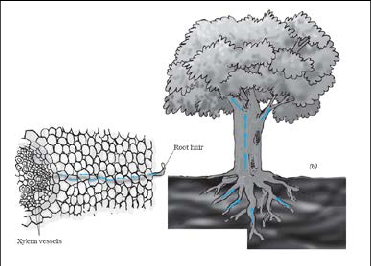
Roots- The Initial Pathway
- Roots play a foundational role in the absorption of water and minerals.
- The presence of root hairs enhances the surface area, facilitating efficient absorption.
Root Hairs- Enhancing Absorption
- Situated in close proximity to water sources present between soil particles, root hairs augment the absorption process.
- Their strategic positioning and structure make them adept at acquiring essential water and minerals dissolved in water.
Movement towards Leaves
- The transportation system within plants operates meticulously, moving water and minerals from roots upwards to various parts of the plant, including leaves.
Vascular Tissues- The Transport Channels
- Xylem- Specialized tissues, known as xylem, act like pipes. They form a continuous network throughout the plant, allowing for efficient transport.
- Role of Xylem- It connects roots to leaves through stems and branches, ensuring water and nutrients reach all parts of the plant.
Phloem- The Food Distributor
- Specialised for Nutrition- After the synthesis of food in leaves, another specialised tissue, phloem, takes charge of transporting this nutrition to various parts of the plant.
- Role of Phloem- Its role ensures that the synthesised food is evenly distributed throughout the plant, catering to the nutritional needs of all parts, whether involved in food synthesis or not.
Tissues- Collections of Specialized Cells
- Tissues in plants are organised groups of cells collated to perform specialised functions, crucial for the survival and growth of the organism.
- In this context, vascular tissues (xylem and phloem) are prime examples, each performing unique yet interconnected roles in the transport system.
Activity -Transportation in Plants
Objective- To visually understand how water and minerals are transported within a plant.
Materials Required-
- A glass tumbler
- Water
- Red ink
- A tender herb (e.g., Balsam)
- A blade
Procedure-
- Preparation- Fill one-third of the glass tumbler with water and add a few drops of red ink to the water.
- Plant Placement- Cut the base of the stem of the herb and place it in the glass, ensuring the cut stem is submerged in the water.
Observations-
- Next-Day Review- The following day, certain parts of the herb might appear red.
- Stem Examination- Cutting across the stem reveals the red colour, indicative of the transportation path of the water and ink.
Conclusions from the Activity-
- Conduction in the Stem- The stem acts as a conductor, facilitating the movement of water upwards.
- Role of Xylem- Narrow tubes known as xylem, present in the stem, play a vital role in this transportation process.
- Mineral Transportation- Alongside water, minerals dissolved in it also move up the stem, reaching various parts of the plant, like the leaves.
Analytical Focus-
- Understanding Transportation- This activity helps in understanding the conduit role of the stem and xylem in transportation.
- Visual Representation- The use of red ink offers a visual representation, making the understanding of the concept clear and concrete.
- Connection with Minerals- The experiment symbolises that, similar to the red ink, essential minerals also travel through the plant’s transportation system.
Transpiration in Plants
What is Transpiration?
- Definition- Transpiration is the process by which plants lose water in the form of water vapour from the surface of their leaves.
- Water and Nutrient Absorption- Plants absorb water and mineral nutrients from the soil, but not all of it is utilised directly.
Process of Transpiration
- Water Evaporation- Excess water absorbed by the plants is evaporated through tiny openings called stomata located on the surface of leaves.
- Role of the Stomata- Tiny openings on the leaves’ surface, known as stomata, act as gateways for water vapour to exit the plant.
- Mechanism- Water absorbed by the roots travels through the plant, reaching the leaves where it evaporates, exiting mainly through the stomata.
Significance of Transpiration-
- Suction Pull Generation- Transpiration creates a vacuum or suction force, enabling the plant to draw water from the roots upwards, assisting in its transport throughout the plant, even against gravity.
- Temperature Regulation- The evaporation of water during transpiration helps maintain the plant’s temperature, preventing overheating and ensuring optimal functioning.
The Transpiration Effect
- Influence on Water Transport- Through transpiration, a continuous flow of water is maintained within the plant, allowing for the efficient delivery of necessary nutrients.
- Environmental Adaptation- Transpiration helps plants adapt to their environment by managing their internal temperature and water balance, crucial for survival and growth.
Class 7 – Science- Chapter 11-Transportation in Animals and Plants Question Answer (Solved MCQs)
